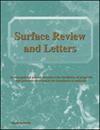Mechanical and Tribology Behavior of Hard-Faced Inconel 718 on Stainless Steel 321
IF 1.2
4区 材料科学
Q4 CHEMISTRY, PHYSICAL
引用次数: 0
Abstract
In this work, the Metal Inert Gas (MIG) welding process is used for depositing the Inconel 718 over the base substrate of Stainless steel 321. The optimal welding conditions like 50% overlap, Direct Current (DC) plus mode with a pulse on time (1–5 s), frequency (0.25–1 Hz), peak current (120 A), base currents (60% of peak current), and speed (150–350 mm/min) are used for the successful hard-facing. The quality of the hard-facing is analyzed by conducting microstructural studies, tensile tests, microhardness, wear behavior, and electrochemical studies. Post-processing for wear and electrochemical studies is done by Scanning Electron Microscope SEM–EDX analysis. Microstructural studies revealed the presence of columnar dendrites and equiaxed at the top of the hard-faced layer. Hard-faced layer depicts the highest ultimate tensile strength of 772 N/mm 2 with an elongation of 31.50% due to the support of Nickel components. The presence of the voids and dimples is identified from the SEM fractography. The maximum hardness value of 212 HV[Formula: see text] is measured at the top of the hard face layer. The microhardness of the hard-faced layer increased by 17.77% higher than its base substrate. Because of the hard precipitates and higher microhardness made by the weld thermal cycle, the hard-face layer showed maximum Co-efficient of Friction (CoF) of 0.540. Debris and grooves are found with the SEM examination of the wear specimens. Higher impedance offers better corrosion resistance to the hard-faced layer Inconel 718. The EDX analysis confirms the presence of Chromium, Molybdenum, and Niobium contents at the hard-faced layer. These elements silently support better corrosion resistance compared to the base substrate of Stainless steel 321.硬面Inconel 718在不锈钢321上的力学和摩擦学行为
在这项工作中,金属惰性气体(MIG)焊接工艺用于在不锈钢321的基板上沉积Inconel 718。最佳焊接条件,如50%重叠,直流(DC) +模式,脉冲接通时间(1-5秒),频率(0.25-1 Hz),峰值电流(120 a),基电流(峰值电流的60%)和速度(150-350 mm/min)用于成功的硬面焊。通过进行微观结构研究、拉伸测试、显微硬度、磨损行为和电化学研究来分析硬表面的质量。对磨损和电化学研究的后处理是通过扫描电子显微镜SEM-EDX分析完成的。显微结构研究显示,在硬面层的顶部存在柱状枝晶和等轴晶。由于镍组分的支持,硬表面层的抗拉强度最高,达到772 N/mm 2,伸长率达到31.50%。通过扫描电镜断口分析,发现了空洞和韧窝的存在。在硬面层顶部测量最大硬度值212 HV[公式:见文]。硬面层的显微硬度比基体提高了17.77%。由于焊接热循环产生了较硬的析出相和较高的显微硬度,硬表面层的摩擦系数(Co-efficient of Friction, CoF)最高可达0.540。对磨损试样进行扫描电镜检查,发现有碎屑和沟槽。较高的阻抗为硬面层Inconel 718提供了更好的耐腐蚀性。EDX分析证实在硬面层中存在铬、钼和铌含量。与不锈钢321的基板相比,这些元素无声地支持更好的耐腐蚀性。
本文章由计算机程序翻译,如有差异,请以英文原文为准。
求助全文
约1分钟内获得全文
求助全文
来源期刊

Surface Review and Letters
工程技术-物理:凝聚态物理
CiteScore
2.20
自引率
9.10%
发文量
139
审稿时长
4.2 months
期刊介绍:
This international journal is devoted to the elucidation of properties and processes that occur at the boundaries of materials. The scope of the journal covers a broad range of topics in experimental and theoretical studies of surfaces and interfaces. Both the physical and chemical properties are covered. The journal also places emphasis on emerging areas of cross-disciplinary research where new phenomena occur due to the presence of a surface or an interface. Representative areas include surface and interface structures; their electronic, magnetic and optical properties; dynamics and energetics; chemical reactions at surfaces; phase transitions, reconstruction, roughening and melting; defects, nucleation and growth; and new surface and interface characterization techniques.
 求助内容:
求助内容: 应助结果提醒方式:
应助结果提醒方式:


